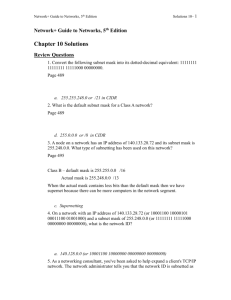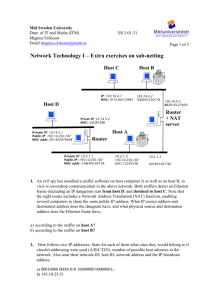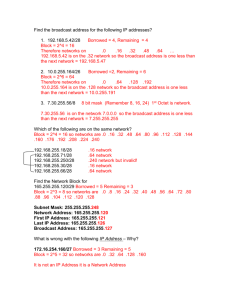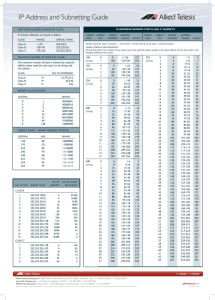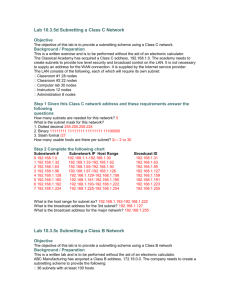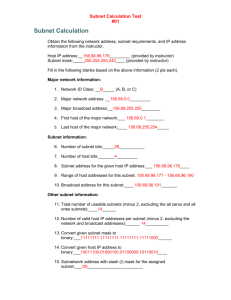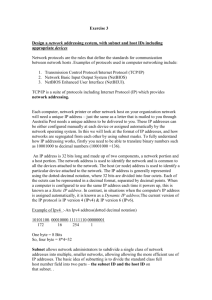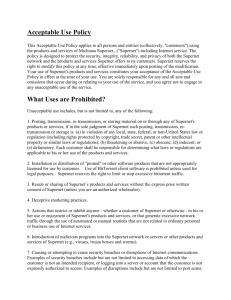Chapter 5
advertisement
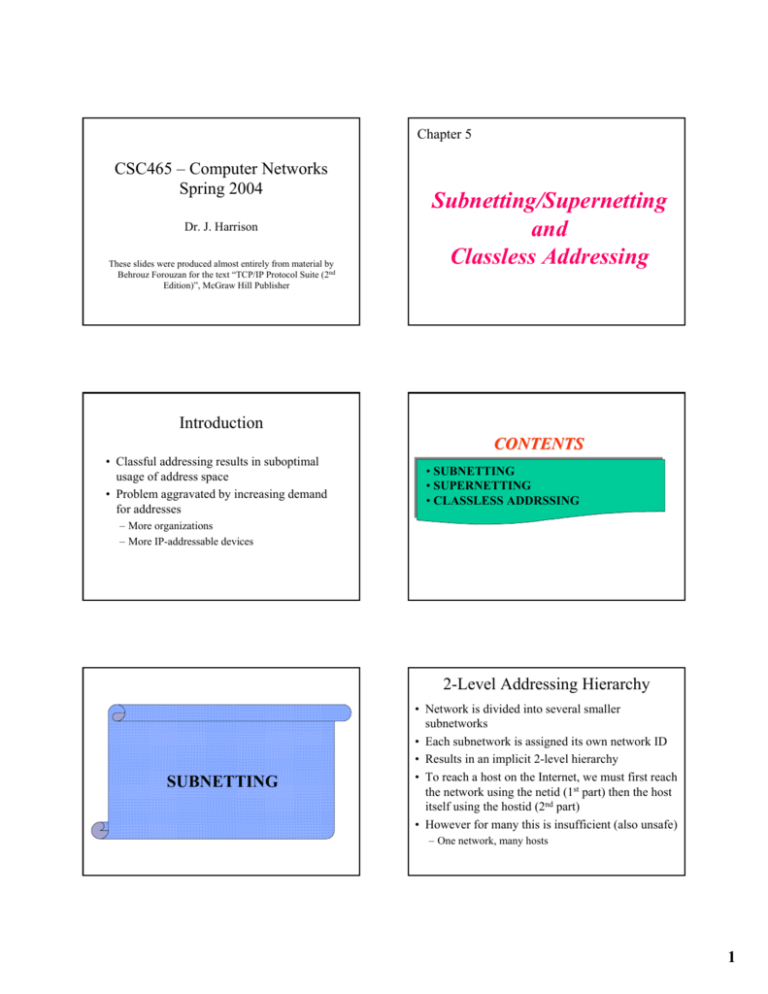
Chapter 5
CSC465 – Computer Networks
Spring 2004
Dr. J. Harrison
These slides were produced almost entirely from material by
Behrouz Forouzan for the text “TCP/IP Protocol Suite (2nd
Edition)”, McGraw Hill Publisher
Subnetting/Supernetting
and
Classless Addressing
Introduction
CONTENTS
• Classful addressing results in suboptimal
usage of address space
• Problem aggravated by increasing demand
for addresses
• SUBNETTING
• SUPERNETTING
• CLASSLESS ADDRSSING
– More organizations
– More IP-addressable devices
2-Level Addressing Hierarchy
SUBNETTING
• Network is divided into several smaller
subnetworks
• Each subnetwork is assigned its own network ID
• Results in an implicit 2-level hierarchy
• To reach a host on the Internet, we must first reach
the network using the netid (1st part) then the host
itself using the hostid (2nd part)
• However for many this is insufficient (also unsafe)
– One network, many hosts
1
A network with two levels of
hierarchy (not subnetted)
Subnetting
• Further partition the address space to create a 3rd
address level: Network ID, Subnet ID and Host ID
• Delivery is three stage process
– To Network, then Subnet and then to Host
Default mask and subnet mask
Example 1
What is the subnetwork address if the
destination address is 200.45.34.56 and the
subnet mask is 255.255.240.0?
Solution
What is the subnetwork address if the
destination address is 200.45.34.56 and the
subnet mask is 255.255.240.0?
11001000 00101101 00100010 00111000
11111111 11111111 11110000 00000000
11001000 00101101 00100000
0000 00000000
The subnetwork address is 200.45.32.0
with 2^12= 4096 available addresses
2
Solution to Example 2
Example 2
What is the subnetwork address if the
destination address is 19.30.80.5 and the
mask is 255.255.192.0?
Comparison of a default mask and
a subnet mask
The number of subnets must be
a power of 2.
The number of 1’s in a default mask is predetermined. (8, 16, 24)
Subnet mask has more ones than default mask.
Example 3
Solution (Continued)
A company is granted the site address
201.70.64.0 (class C). The company needs
six subnets. What is the subnet mask?
Design the subnets.
Solution
The number of 1s
mask is 24 (class C).
in
the
default
The company needs six subnets. This number
6 is not a power of 2. The next number that is
a power of 2 is 8 (23). We need 3 more 1s in
the subnet mask. The total number of 1s in
the subnet mask is 27 (24 + 3).
The total number of 0s is 5 (32 − 27). The
subnet mask is:
3
Solution (Continued)
Example 3
11111111 11111111 11111111 11100000
or
255.255.255.224
The number of subnets is 8.
The number of addresses in each subnet
is 25 (5 is the number of 0s) or 32.
Example 4
A company is granted the site address
181.56.0.0 (class B). The company needs
1000 subnets. Design the subnets.
Solution
The number of 1s in the default mask is 16
(class B).
Solution (Continued)
Solution (Continued)
The company needs 1000 subnets. This
number is not a power of 2. The next number
that is a power of 2 is 1024 (210). We need 10
more 1s in the subnet mask.
The total number of 1s in the subnet mask is
26 (16 + 10).
The total number of 0s is 6 (32 − 26).
Example 4
The mask is
11111111 11111111 11111111 11000000
or
255.255.255.192.
The number of subnets is 1024.
The number of addresses in each subnet is 26
(6 is the number of 0s) or 64.
4
Variable-length subnetting
A Supernetwork
SUPERNETTING
Rules:
** The number of blocks must be a power of 2 (1,
2, 4, 8, 16, . . .).
** The blocks must be contiguous in the address
space (no gaps between the blocks).
** The third byte of the first address in the
superblock must be evenly divisible by the number
of blocks. In other words, if the number of blocks is
N, the third byte must be divisible by N.
Example 5
A company needs 600 addresses. Which of
the following set of class C blocks can be
used to form a supernet for this company?
198.47.32.0 198.47.33.0 198.47.34.0
198.47.32.0 198.47.42.0 198.47.52.0 198.47.62.0
198.47.31.0 198.47.32.0 198.47.33.0 198.47.52.0
198.47.32.0 198.47.33.0 198.47.34.0 198.47.35.0
5
Solution
1: No, there are only three blocks.
2: No, the blocks are not contiguous.
In subnetting,
subnetting,
we need the first address of the
subnet and the subnet mask to
define the range of addresses.
3: No, 31 in the first block is not divisible by 4.
4: Yes, all three requirements are fulfilled.
Figure 5-12
Comparison of subnet, default,
and supernet masks
In supernetting,
we need the first address of
the supernet
and the supernet mask to
define the range of addresses.
Example 6
Example 7
We need to make a supernetwork out of 16
class C blocks. What is the supernet mask?
Solution
We need 16 blocks. For 16 blocks we need to
change four 1s to 0s in the default mask. So the
mask is
11111111 11111111 11110000 00000000
or
A supernet has a first address of 205.16.32.0 and a
supernet mask of 255.255.248.0. A router receives three
packets with the following destination addresses:
205.16.37.44
205.16.42.56
205.17.33.76
Which packet belongs to the supernet?
255.255.240.0 (240/16 = 15)
6
Example 8
Solution
We apply the supernet mask to see if we can find
the beginning address.
205.16.37.44 AND 255.255.248.0
Î 205.16.32.0
205.16.42.56 AND 255.255.248.0
Î 205.16.40.0
205.17.33.76 AND 255.255.248.0
Î 205.17.32.0
A supernet has a first address of 205.16.32.0
and a supernet mask of 255.255.248.0.
How many blocks are in this supernet and
what is the range of addresses?
Only the first address belongs to this supernet.
Example 8
A supernet has a first address of 205.16.32.0 and a
supernet mask of 255.255.248.0. How many blocks are in
this supernet and what is the range of addresses?
Solution
The supernet has 21 1s. The default mask has 24
1s. Since the difference is 3, there are 23 or 8
blocks in this supernet. The blocks are 205.16.32.0
to 205.16.39.0. The first address is 205.16.32.0.
The last address is 205.16.39.255.
5.3
CLASSLESS
ADDRESSING
Figure 5-13
Variable-length blocks
Number of Addresses in a Block
There is only one condition on the number
of addresses in a block; it must be a power
of 2 (2, 4, 8, . . .). A household may be
given a block of 2 addresses. A small
business may be given 16 addresses. A large
organization may be given 1024 addresses.
7
Example 9
Beginning Address
The beginning address must be evenly divisible
by the number of addresses. For example, if a
block contains 4 addresses, the beginning
address must be divisible by 4. If the block has
less than 256 addresses, we need to check only
the rightmost byte. If it has less than 65,536
addresses, we need to check only the two
rightmost bytes, and so on.
Example 9
Which of the following can be the beginning
address of a block that contains 16
addresses?
205.16.37.32
190.16.42.44
17.17.33.80
123.45.24.52
Example 10
Which of the following can be the beginning address of a
block that contains 16 addresses?
Which of the following can be the beginning address of a
block that contains 1024 addresses?
205.16.37.32
190.16.42.44
17.17.33.80
123.45.24.52
205.16.37.32
190.16.42.0
17.17.32.0
123.45.24.52
Solution
Solution
The address 205.16.37.32 is eligible because 32 is
divisible by 16. The address 17.17.33.80 is eligible
because 80 is divisible by 16.
To be divisible by 1024, the rightmost byte of an
address should be 0 and the second rightmost byte
must be divisible by 4. Only the address 17.17.32.0
meets this condition.
Figure 5-14
Slash notation
Slash notation is also called
CIDR
notation.
8
Example 11
A small organization is given a block with
the beginning address and the prefix length
205.16.37.24/29 (in slash notation).
What is the range of the block?
Example 11
A small organization is given a block with the beginning
address and the prefix length 205.16.37.24/29 (in slash
notation). What is the range of the block?
Solution
The beginning address is 205.16.37.24. To find the
last address we keep the first 29 bits and change the
last 3 bits to 1s.
Beginning:11001111 00010000 00100101 00011000
Ending : 11001111 00010000 00100101 00011111
There are only 8 addresses in this block.
Example 12
We can find the range of addresses in Example 11 by
another method. We can argue that the length of the
suffix is 32 − 29 or 3. So there are 23 = 8 addresses in this
block. If the first address is 205.16.37.24, the last address
is 205.16.37.31 (24 + 7 = 31).
Example 13
What is the network address if one of the
addresses is 167.199.170.82/27?
A block in classes A, B, and C
can easily be represented in slash
notation as
A.B.C.D/ n
where n is
either 8 (class A), 16 (class B), or
24 (class C).
Example 13
What is the network address if one of the addresses is
167.199.170.82/27?
Solution
The prefix length is 27, which means that we must
keep the first 27 bits as is and change the remaining
bits (5) to 0s. The 5 bits affect only the last byte.
The last byte is 01010010. Changing the last 5 bits
to 0s, we get 01000000 or 64. The network address
is 167.199.170.64/27.
9
Example 14
Solution (Continued)
An organization is granted the block 130.34.12.64/26.
The organization needs to have four subnets. What are the
subnet addresses and the range of addresses for each
subnet?
Let us first find the subnet prefix (subnet mask).
We need four subnets, which means we need to add
two more 1s to the site prefix. The subnet prefix is
then /28.
Solution
Subnet 1: 130.34.12.64/28 to 130.34.12.79/28.
The suffix length is 6. This means the total number
of addresses in the block is 64 (26). If we create
four subnets, each subnet will have 16 addresses.
Subnet 2 : 130.34.12.80/28 to 130.34.12.95/28.
Subnet 3: 130.34.12.96/28 to 130.34.12.111/28.
Subnet 4: 130.34.12.112/28 to 130.34.12.127/28.
See Figure 5.15
Figure 5-15
Example 14
Example 15
An ISP is granted a block of addresses starting with
190.100.0.0/16. The ISP needs to distribute these
addresses to three groups of customers as follows:
1. The first group has 64 customers; each needs 256 addresses.
2. The second group has 128 customers; each needs 128 addresses.
3. The third group has 128 customers; each needs 64 addresses.
Design the subblocks and give the slash notation for each
subblock. Find out how many addresses are still available
after these allocations.
Solution
{00000000.00000000}-{00111111.11111111}
(Continued)
{01000000.00000000}-{01111111.11111111}
Group 1
Group 2
For this group, each customer needs 256 addresses.
This means the suffix length is 8 (28 = 256). The
prefix length is then 32 − 8 = 24.
For this group, each customer needs 128 addresses.
This means the suffix length is 7 (27 = 128). The
prefix length is then 32 − 7 = 25. The addresses
are:
01: 190.100.0.0/24 Î190.100.0.255/24
02: 190.100.1.0/24 Î190.100.1.255/24
…………………………………..
64: 190.100.63.0/24Î190.100.63.255/24
Total = 64 × 256 = 16,384
001: 190.100.64.0/25
Î190.100.64.127/25
002: 190.100.64.128/25
Î190.100.64.255/25
003: 190.100.127.128/25 Î190.100.127.255/25
Total = 128 × 128 = 16,384
10
(Continued)
Group 3
{10000000.00000000}-{10001111.11111111}
For this group, each customer needs 64 addresses.
This means the suffix length is 6 (26 = 64). The
prefix length is then 32 − 6 = 26.
001:190.100.128.0/26
Î190.100.128.63/26
002:190.100.128.64/26
Î190.100.128.127/26
Solution (Continued)
Number of granted addresses: 65,536
Number of allocated addresses: 40,960
Number of available addresses: 24,576
…………………………
128:190.100.159.192/26 Î190.100.159.255/26
Total = 128 × 64 = 8,192
11

